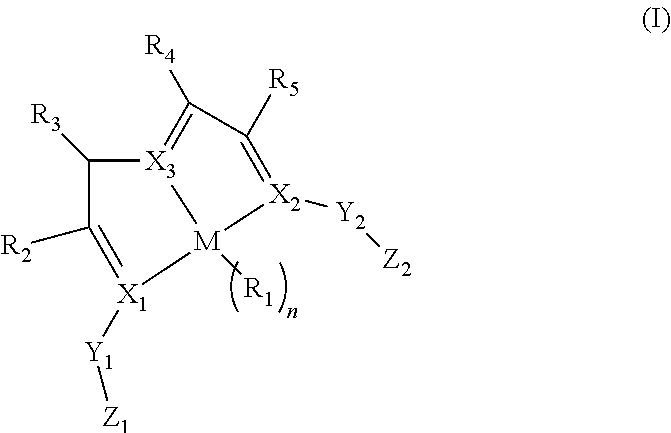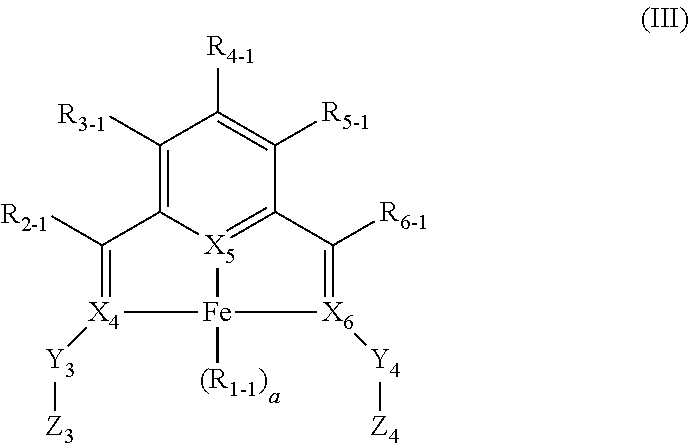Enantiopure base-metal catalysts for asymmetric catalysis and bis(IMINO)pyridine iron alkyl complexes for catalysis
- Summary
- Abstract
- Description
- Claims
- Application Information
AI Technical Summary
Benefits of technology
Problems solved by technology
Method used
Image
Examples
example 1
Hydrogenation of Olefin A with Compound 1
[0145]In a drybox under a nitrogen atmosphere, 5 mole % of compound 1 and olefin A were placed in a glass vessel and dissolved in benzene. The glass vessel was taken out of the drybox and transferred to a high vacuum line. Following evacuation of the dinitrogen atmosphere, the glass vessel was loaded with four atmospheres of hydrogen (H2), and the hydrogenation of olefin A was then carried out in the presence of compound 1 and at a temperature of 22° C. The reaction is shown below in Scheme 3. The conversion percentage and enantiomeric excess for the product are reported below in Table 1.
examples 2-9
Hydrogenation of Olefin B to I with Compound 1
[0146]The same hydrogenation as Example 1 was carried out in these examples, with the exception of replacing olefin A with olefins B to I shown below in Scheme 4. The conversion percentages and enantiomeric excesses for the products are reported below in Table 1.
TABLE 1ExampleOlefinConversion %ee1A 87%90% R2B 70%80% R3C 5%>98% R 4D>98%96% R5E>98%94% R6F>98%90% R7G>98%78% R8H>98%66% R9I>99%39% S
[0147]In Table 1, the conversion percentage refers to the percent of olefin converted to the alkane, relative to the entire amount of the olefin. This percentage and the enantiomeric excess values were determined with a gas chromatography (GC) flame ionization detector. GC analyses to determine the conversion percentages were performed using a Shimadzu GC-2010 gas chromatograph equipped with a Shimadzu AOC-20s autosampler, a Shimadzu SHRXI-5MS capillary column (15 m×250 μm) and a flame-ionization detector. UHP-grade helium was used as carrier gas ...
example 10
Hydrogenation of Substrate I in the Presence of Compound 2
[0148]The same reaction of Example 9 was carried out, except that the olefin I was hydrogenated in the presence of compound 2. The conversion of olefin I in the presence of compound 2 was 44%. However, the enantiomeric excess in favor of the S enantiomer was 96%.
PUM
| Property | Measurement | Unit |
|---|---|---|
| Molecular structure | aaaaa | aaaaa |
Abstract
Description
Claims
Application Information
 Login to View More
Login to View More - R&D
- Intellectual Property
- Life Sciences
- Materials
- Tech Scout
- Unparalleled Data Quality
- Higher Quality Content
- 60% Fewer Hallucinations
Browse by: Latest US Patents, China's latest patents, Technical Efficacy Thesaurus, Application Domain, Technology Topic, Popular Technical Reports.
© 2025 PatSnap. All rights reserved.Legal|Privacy policy|Modern Slavery Act Transparency Statement|Sitemap|About US| Contact US: help@patsnap.com



